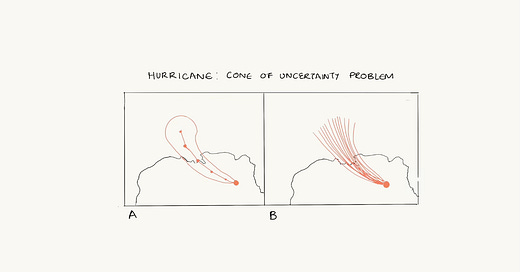Rethink: How to make decisions in an uncertain world
Grey areas, wishful thinking and the ‘Cone of ‘Uncertainty’
Dear Rethinkers,
As many of you will know, I’m passionate about helping people think more like designers. I’ve always considered design an enabler, the way you transfer ideas from one mind to another. But there is one design challenge that has stumped designers for decades that I thought would be fun to explore in this week’s newsletter – how do we visualise uncertainty, and why does this matter?
Typically, a designer has to visualise something we want to know — the outcome of something. The challenge is that the information available on, say, an election or pandemic can’t answer the questions we have. And most of us don’t like grey areas — the liminal space between all and nothing.
When uncertainty is poorly visualised, it can lead people to the wrong conclusions or the wrong decisions in everything from budgeting to the outcome of a murder trial, to whether to stay or leave in a hurricane.
Wishful thinking
When tracking a hurricane, weather forecasters often show a map with a cone overlay. The tip point of the cone marks the hurricane’s current position. The shape then widens to cover where the storm might head in the upcoming days. The most likely path is the bold line running down the centre.
The problem is that many people misinterpret the cone as the actual size of the future storm and the line as the storm’s real-time path. Why do we do this?
Design often amplifies a common human flaw: wishful thinking gives people a sense of control.
Read on to find out what we can learn from the ‘Cone of Uncertainty’ problem, and how to thrive in an era full of unknowns.




